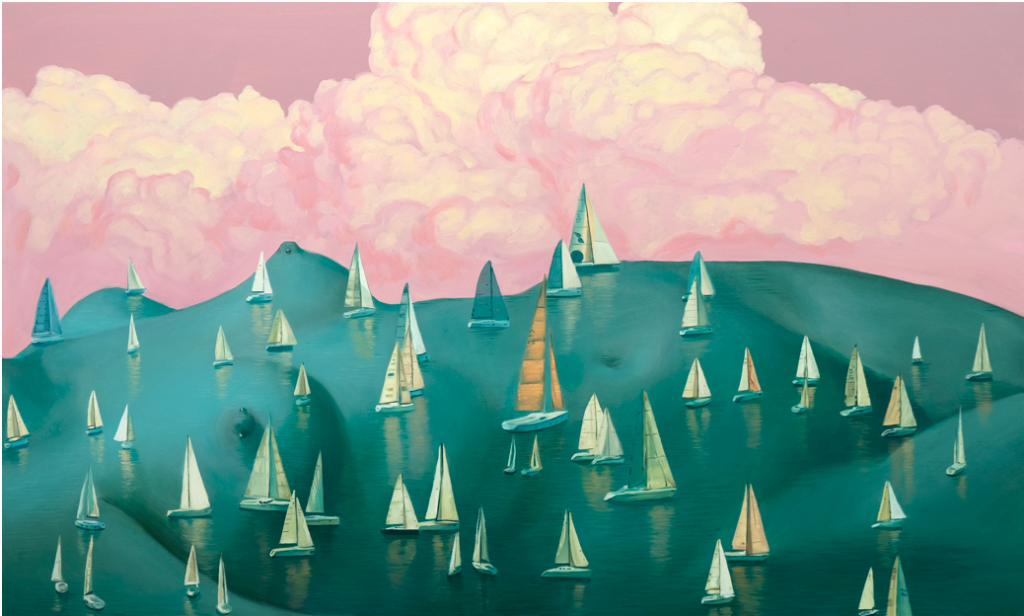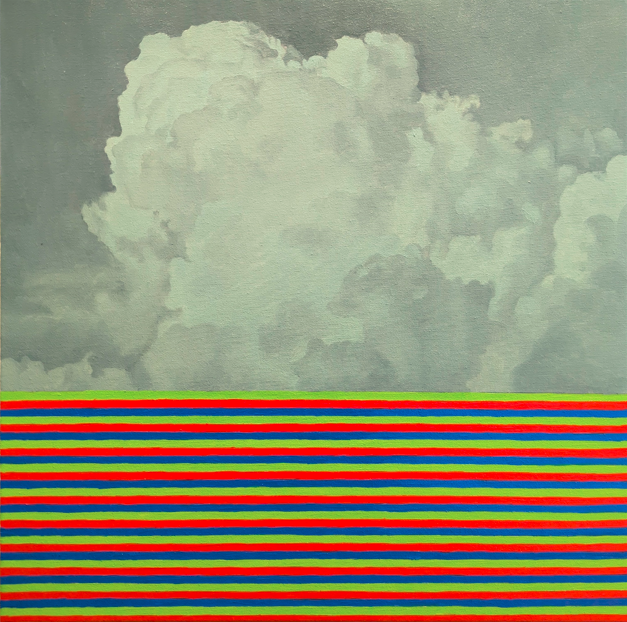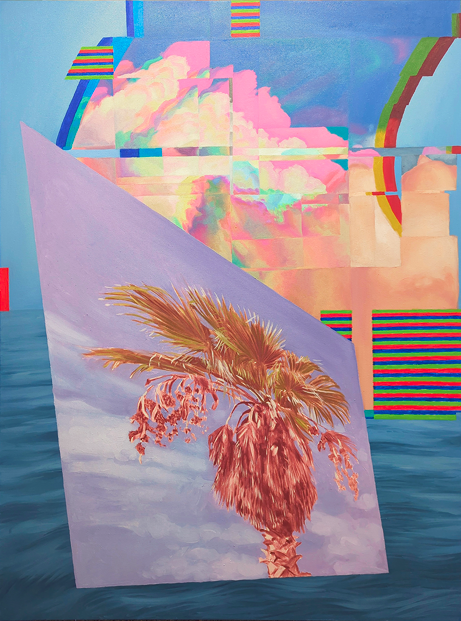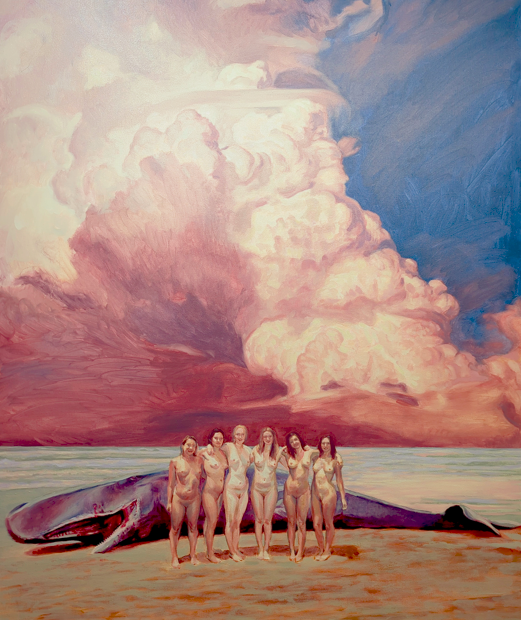Exploraciones: Conversación con Nora Marin-Hall en torno a su obra
Con Juan Pablo Torres Muñiz
Hacer de las formas, signos y, del volumen mismo, carga de significados, además de convertir el cuerpo en símbolo… Parece difícil aportar algo nuevo al respecto, más allá de la simple forma. Las exploraciones abundan, las propuestas definidas, felizmente, también, pero resulta bastante complicado dar con algo consistente que no requiera, de veras, de más explicaciones que las uno mismo puede darse, a partir de cierta formación, claro. La elocuencia a la que nos referimos, se basa en una relación consistente con la tradición, a la vez que, en su traición, con frecuencia sutil.
Conversamos con Nora sobre su proceso creativo, a fin de echar luces sobre su obra, que dice lo suyo por sí misma.

Los cuerpos humanos y los objetos inanimados aparecen aquí como algo más que simples objetos: son un medio de expresión… ¿Es posible considerar esto más allá de la pintura misma?
¿Por qué la pintura y no otra forma de arte?
Mi padre, mi abuelo y mi bisabuela fueron pintores. Crecí admirando los retratos de la familia que pintaba mi abuelo y los paisajes de mi bisabuela. Decidí que sería pintora a los 5 años. He incursionado en otros medios como la música, la fotografía y la escritura. También me encantan, pero siempre vuelvo a la pintura y el dibujo. En este punto, es una parte fundamental de mi existencia.

¿Cómo decides qué pintar? ¿Cómo surgen tus motivos?
Realmente no lo decido. Muchas ideas simplemente aparecen en mi cabeza y las sigo si se sienten bien. Las pinturas con veleros surgieron cuando empecé a competir en regatas de vela. Me aficiono cada vez más a la pesca submarina, así que han empezado a aparecer ballenas y tiburones muertos. Algunas de las pinturas de desnudos que he hecho surgieron durante épocas de… relaciones complicadas. Siento que la mayoría de los sentimientos y situaciones es mejor registrarlos que racionalizarlos.

Tu trabajo gira en torno a una configuración de la realidad más allá del rigor lógico, donde las imágenes se distorsionan y superponen… ¿Qué hay de la realidad y la verdad en tu enfoque?
La ilusión de la realidad es un tema que visito mucho. Me gusta aplanar, torcer, y deformar objetos y figuras para dar la sensación de que la realidad se debilita. Me inclino por la idea de que la vida y nuestra percepción de ella son un juego que estamos jugando. Pensar así le quita filo a mi ansiedad existencial. La pintura realista es en sí misma una realidad falsa; un montón de colores dispuestos de manera que engañan a tu ojo y cerebro para que crean que es una cosa. El realismo como metáfora de una realidad falsa es una de mis formas favoritas de pensar sobre la pintura.

Libertad, razón, arbitrariedad, quizás incluso capricho… ¿Hasta qué punto puede describirse tu obra como una propuesta tentadora, que se balancea en el borde del idealismo y sin embargo es crítica?
Ciertamente, me gusta que la describan de esa manera.
¿Qué influencias reconoces en tu obra?
Algunas de las cosas recientes que he estado pintando, con esas nubes grandes y cielos dramáticos, me hacen sentir que estoy copiando un poco a John Brosio. En realidad, creo que John es uno de mis pintores favoritos de todos los tiempos, lo cual es incómodo porque lo conozco personalmente. Me obsesiona el movimiento en las pinturas de Peter Paul Rubens y siempre estoy tratando de averiguar cómo puedo replicar algo de eso. No puedo pintar una figura o un retrato sin pensar en John Singer Sargent y en cómo lo abordaría él, aunque no me acerco a su habilidad y quizás nunca lo haga.

¿Hacia dónde se dirige tu trabajo ahora?
Más cielos grandes y dramáticos. Más desnudos. Quizás más veleros y peces y ballenas muertos. Más movimiento y experimentos. Me encantaría incorporar algo de escultura a mi práctica de nuevo. ¡Ya veremos qué surge!
Lo veremos…

ENGLISH (ORIGINAL VERSION)
Explorations: A Conversation with Nora Marin-Hall about her Work
Translation by Rebeca Sanz
To make forms, signs, and volume itself bearers of meaning, in addition to turning the body into a symbol… It seems difficult to contribute something new in this regard, beyond mere form. Explorations abound, defined proposals, happily, do too, but it is quite complicated to find something consistent that does not truly require more explanation than what one can provide for oneself, given a certain background, of course. The eloquence we refer to is based on a consistent relationship with tradition, while simultaneously, and often subtly, betraying it.
We spoke with Nora Marin-Hall about her creative process, to shed light on her work, which speaks for itself.
Human bodies and inanimate objects appear here as more than just objects—they are a means of expression… Is it possible to consider this beyond painting itself?
Why painting and not another art form?
My father, grandfather and great grandmother were all painters. I grew up admiring my grandfather’s portraits of the family and my great grandmother’s landscape paintings. I decided I’d be a painter at 5 years old. I’ve dabbled in other mediums like music, photography and writing. I love doing those too, but it always comes back to painting and drawing. It’s a foundational part of my existence at this point.
How do you decide what to paint? How do your motifs emerge?
I don’t really decide. A lot of it just pops into my head and I run with it if it feels right. The paintings with sailboats happened when I started racing sailboats. I’m getting more into spearfishing so dead whales and sharks have started to show up. Some of the paintings of nudes I’ve made happened during complicated relationship/dating times. I feel like most feelings/situations are better off being recorded rather than rationalized.
Your work revolves around a configuration of reality beyond logical rigor, where images are distorted and superimposed… What about reality and truth in your approach?
The illusion of reality is a theme I visit a lot. I like to flatten/twist/glitch/warp objects and figures to give the feeling of reality weakening. I lean into the idea that life and our perception of it is all a game we’re playing. Thinking of it that way takes the edge off of my existential anxiety. Realistic painting is itself a fake reality; a bunch of colors arranged in a way to trick your eye and brain into believing it’s a thing. Realism as a metaphor for a fake reality is one of my favorite ways to think about painting.
Freedom, reason, arbitrariness, perhaps even caprice… To what extent can your work be described as a tempting proposal, teetering on the edge of idealism yet critical?
I certainly like it being described that way.
What influences do you recognize in your work?
Some of the recent stuff I’ve been painting with the big clouds and dramatic skies makes me feel like I’m ripping off John Brosio a little. Actually, I think John is one of my favorite painters of all time, which is awkward because I know him personally. I obsess over the movement in Peter Paul Reubens’ paintings and I’m always trying to figure out how I can replicate some of that. I can’t paint a figure or portrait without thinking about John Singer Sargent and how he might approach it, though I don’t get close to his ability and perhaps never will.
Where is your work heading now?
More big dramatic skies. More nudes. Perhaps more sailboats and dead fish and whales. More movement and experiments. I’d love to incorporate some sculpture into my practice again. We’ll just see what comes up!
Yes…
